The Iranian-built “Berno” was originally designed by Czechoslovakia’s Zbrojovka Brno Company, which was a weapons and vehicle manufacturing firm. The Czechoslovak rifle was actually based on the German Gew 98b design. Technically, this was the Mauser 1898, featuring a total length of 1250 mm, originally as the G98 (meaning Gewehr 98, meaning the 1898 rifle 1898 model for the Imperial German Army). This design was so reliable that it influenced the production of some models of the US Springfield and British Lee-Enfield rifles.
 The original Mauser G98 from which the Czechoslovak Brno was based on (Picture Source: Aliparsa.com). Several industrialized nations have built the Mauser rifle and clones have been made in virtually every through license agreements with the Mauser firm in Orberndorf, Germany. One of the most prominent of these licensing arrangements was made with Czechoslovakia which led to the production (also via licensing) of high-quality models in Iran as well. Several other nations have also produced the Mauser-based rifle, including, Turkey, Peru, Venezuela, Brazil, Spain, Mexico, Sweden, Belgium, Argentina, and Yugoslavia.
The original Mauser G98 from which the Czechoslovak Brno was based on (Picture Source: Aliparsa.com). Several industrialized nations have built the Mauser rifle and clones have been made in virtually every through license agreements with the Mauser firm in Orberndorf, Germany. One of the most prominent of these licensing arrangements was made with Czechoslovakia which led to the production (also via licensing) of high-quality models in Iran as well. Several other nations have also produced the Mauser-based rifle, including, Turkey, Peru, Venezuela, Brazil, Spain, Mexico, Sweden, Belgium, Argentina, and Yugoslavia.
It did not take long for this venerable weapon with its excellent bolt-action technology to find its way into Iran by the early 1900s. Iranian Constitutional fighters used this weapon in their battles to promote what was Western Asia’s first Democracy movement.
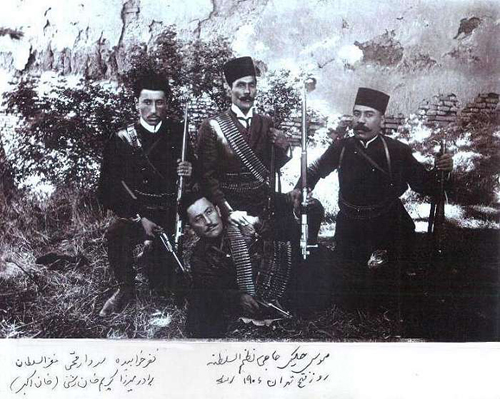 An excellent photo of Iranian Constitutional Fighters armed with the Mauser (Picture Source: Aliparsa.com). This weapon was to be later introduced on a much larger scale as the Iranian army manufactured it under license from the Czechoslovak Zbrojovka Brno Company.
An excellent photo of Iranian Constitutional Fighters armed with the Mauser (Picture Source: Aliparsa.com). This weapon was to be later introduced on a much larger scale as the Iranian army manufactured it under license from the Czechoslovak Zbrojovka Brno Company.
By the mid-1920s, two other types of rifles were being used in Iran: the Russian Mosin-Nagant (Noghaan, or Naaghaan, نوغان- ناغان in the popular slang of the time) and the British Lee-Enfield. Explanations vary as to why the administration of Reza Shah chose to adopt the Mauser-based Brno. One strong possibility is that Reza Shah wanted to distance the Iranian army’s reliance on Britain and Russia as sources of military supplies. Whatever the true reason, the Iranian Army opted to adopt the Berno (Brno) as its primary infantry rifle. In addition, the Berno (Brno) was considered to be the best rifle of its type at the time.
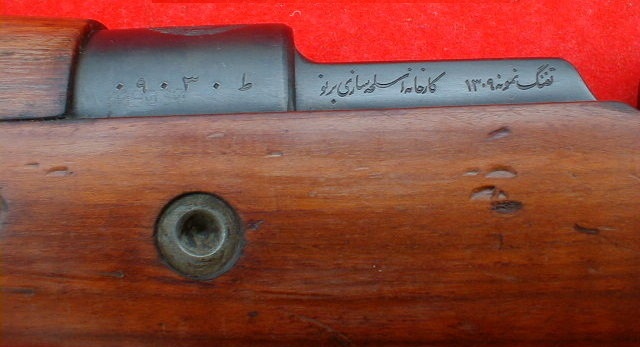 The original delivery Berno [Brno] manufactured in Czechoslovakia for the Iranian army (Picture Source: Milpas). Note the Persian writing which states “Karkhaneye Aslahe-Saziye Berno [Lit. Brno Weapons manufacturing Factory]”. The Jalali Calendar date of 1309 on the rifle places its date of manufacture to 1930.
The original delivery Berno [Brno] manufactured in Czechoslovakia for the Iranian army (Picture Source: Milpas). Note the Persian writing which states “Karkhaneye Aslahe-Saziye Berno [Lit. Brno Weapons manufacturing Factory]”. The Jalali Calendar date of 1309 on the rifle places its date of manufacture to 1930.
Iran was to later produce the weapon under license. By the late 1940s, the Taslihat-e Artesh (Arms Factories of the Army) in Tehran, known colloquially as “Mosalsal-sazi” (lit. machine-gun construction), engaged in the mass-production of the Berno [Brno].
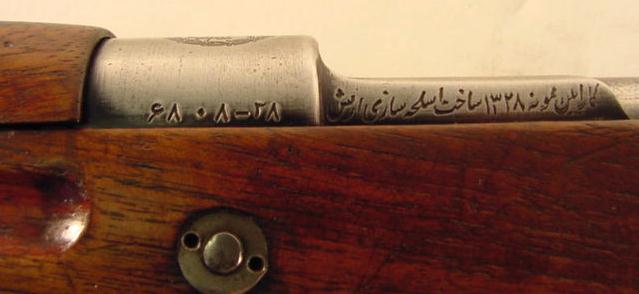 A version of the Berno (Brno) produced in Iran in 1949 – Jalali calendar of 1328 (Picture Source: Aliparsa.com). The Persian script states “Sakht-e Aslehe-Sazi-e Artesh” [lit. Built by the Weapons Manufacturing of the Army].
A version of the Berno (Brno) produced in Iran in 1949 – Jalali calendar of 1328 (Picture Source: Aliparsa.com). The Persian script states “Sakht-e Aslehe-Sazi-e Artesh” [lit. Built by the Weapons Manufacturing of the Army].
The Iranian army considered the “Berno” (Brno) as the best military rifle of its time. Iranian veterans have noted of the sturdiness and reliability of this rifle. Iranian tribal warriors especially valued the Berno (Brno) well into the late 1970s.
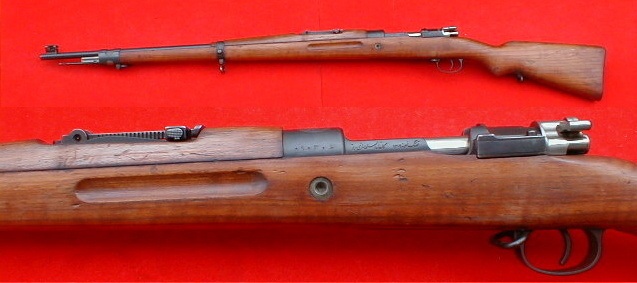 A more comprehensive view of the 1930 Czech manufacture Berno [Brno] (Picture Source: Milpas).
A more comprehensive view of the 1930 Czech manufacture Berno [Brno] (Picture Source: Milpas).
The Iranian built Berno (Brno) came in two versions:
1) the regular Berno (Brno) (Length=1110 mm): this was technically the regular VZ24 rifle, highly similar to the Kar-98k of Germany.
2) a shorter version of the Berno (Brno) known as Berno e Kootah (the short Berno) (Length=993 mm): this was similar to the G-30 of Germany.
The Berno e Kootah (the short Berno) (Picture Source: Aliparsa.com). The required machinery and training for producing the Berno (Brno) rifles was provided by the Czech powerhouse firm, Škoda, which had long-standing ties with the Iranian industrial sector.
The Berno (Brno) remained as the standard weapon of the Iranian army until 1960 when it was finally replaced by the US- M1 Garand semi-automatic rifle. The M1 in turn was replaced by the German-designed G3 of Heckler and Koch in the 1970s. The Berno however was to remain in service with the Iranian Gendarmerie until 1979.
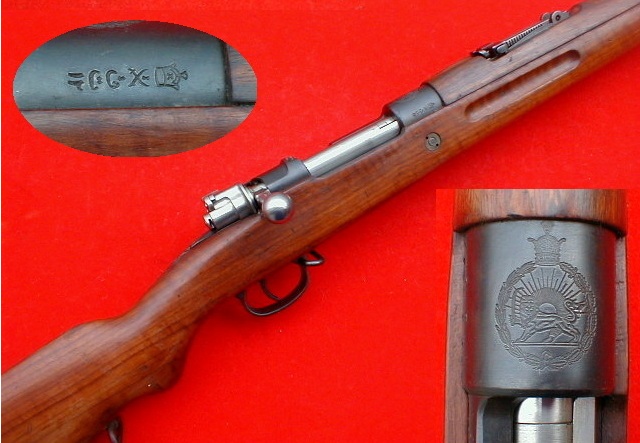 Another view of the 1930 Czech manufactured Brno; note close-ups of the insignia and the Lion and Sun symbol (Picture Source: Milpas).
Another view of the 1930 Czech manufactured Brno; note close-ups of the insignia and the Lion and Sun symbol (Picture Source: Milpas).
Despite its phasing out in the 1960s-1970s, the Berno (Brno) continued to earn the admiration and respect of the Iranian infantrymen.
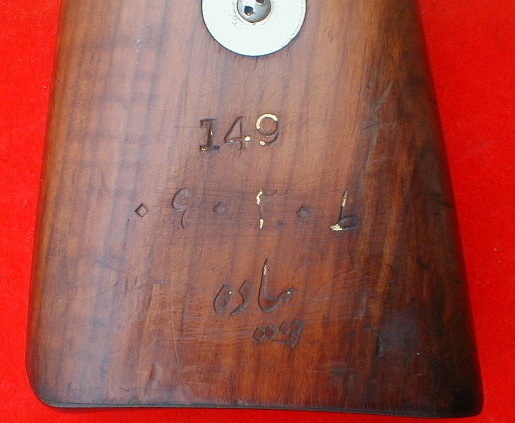 Yet another view of the 1930 Czech manufacture Brno; the section above has the Persian word “Piyade” which roughly translates as “Infantryman”, but the term is better translated as “on Foot”. The term (Piyade) in Iranian military lexicon is meant to be differentiated from the Savar (mounted cavalryman) (Picture Source: Milpas).
Yet another view of the 1930 Czech manufacture Brno; the section above has the Persian word “Piyade” which roughly translates as “Infantryman”, but the term is better translated as “on Foot”. The term (Piyade) in Iranian military lexicon is meant to be differentiated from the Savar (mounted cavalryman) (Picture Source: Milpas).
The Berno (Brno) was to serve the Iranian Army with special effectiveness, especially against Soviet-trained persons who were fighting against Tehran to advance the cause of the former Soviet Union inside Iran.
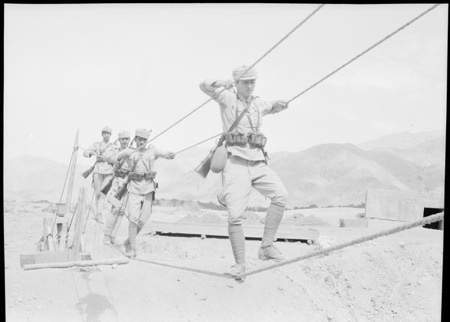 Iranian soldiers in training during the allied occupation of Iran (Picture Source: MilitaryPhotos.net); note the Berno [Brno] rifles slung on their shoulders during the exercises. When Russia withdrew her military umbrella from her satellite states in northern Iran in May 1946, the Moscow-Baku controlled separatist movements of northwest Iran quickly collapsed as the Iranian army entered the region in December 1946 (For more information seeIran at War: 1500-1988-(ایران در جنگ (۱۹۸۸-۱۵۰۰- 2011 –pp. 283-293).
Iranian soldiers in training during the allied occupation of Iran (Picture Source: MilitaryPhotos.net); note the Berno [Brno] rifles slung on their shoulders during the exercises. When Russia withdrew her military umbrella from her satellite states in northern Iran in May 1946, the Moscow-Baku controlled separatist movements of northwest Iran quickly collapsed as the Iranian army entered the region in December 1946 (For more information seeIran at War: 1500-1988-(ایران در جنگ (۱۹۸۸-۱۵۰۰- 2011 –pp. 283-293).





